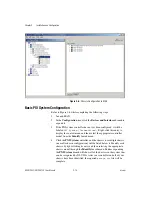
Chapter 1
Getting Started
NI PXI-1031/PXI-1031DC User Manual
1-8
ni.com
Figure 1-5.
PXI Star Trigger and Local Bus Routing
Trigger Bus
All slots share eight PXI trigger lines. You can use these trigger lines
in a variety of ways. For example, you can use triggers to synchronize
the operation of several different PXI peripheral modules. In other
applications, one module located in slot 2 can control carefully timed
sequences of operations performed on other modules in the system.
Modules can pass triggers to one another, allowing precisely timed
responses to asynchronous external events the system is monitoring
or controlling.
System Reference Clock
The PXI-1031/PXI-1031DC supplies the PXI 10 MHz system clock signal
(PXI_CLK10) independently to each peripheral slot. An independent
buffer (having a source impedance matched to the backplane and a skew of
less than 1 ns between slots) drives the clock signal to each peripheral slot.
You can use this common reference clock signal to synchronize multiple
modules in a measurement or control system. You can drive PXI_CLK10
from an external source through the PXI_CLK10_IN pin on the
P2 connector of the star trigger slot. Refer to Table B-4,
Pinout for the Star Trigger Slot
. You must manually switch SW1 on the
chassis backplane to enable or disable routing an external clock to
peripheral slots.
System Controller Slot [1]
Star Trigger/Peripheral Slot [2]
Peripheral Slot [3]
Peripheral Slot [4]
Local
Bus
Local
Bus
Star Triggers
PCI Arbitration and Clock Signals









































